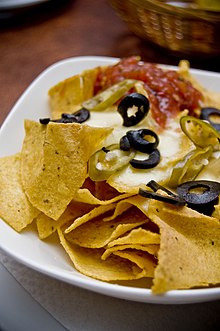 Nachos with tortilla chips, melted or not melted cheese, olives, jalapeño peppers, sour cream, and salsa Nachos with tortilla chips, melted or not melted cheese, olives, jalapeño peppers, sour cream, and salsa | |
| Course | Snack, appetizer, or main course |
|---|---|
| Place of origin | Mexico |
| Region or state | |
| Associated cuisine | Tex-Mex cuisine |
| Created by | Ignacio Anaya |
| Main ingredients | Tortilla chips, cheese |
| Ingredients generally used | Various toppings |
Nachos are a Tex-Mex culinary dish consisting of tortilla chips or totopos covered with cheese or cheese sauce, as well as a variety of other toppings and garnishes, often including meats (such as ground beef or grilled chicken), vegetables (such as chili peppers, lettuce, tomatoes, and olives), and condiments such as salsa, guacamole, or sour cream. At its most basic form, nachos may consist of merely chips covered with cheese (usually cheddar or American cheese), and served as an appetizer or snack, while other versions are substantial enough to serve as a main course. The dish was created by, and named after, Mexican restaurateur Ignacio "Nacho" Anaya, who created it in 1943 for American customers at the Victory Club restaurant in Piedras Negras, Coahuila.
History
Nachos originated in the city of Piedras Negras, Coahuila in Mexico, across the border from Eagle Pass, Texas in the United States. Ignacio "Nacho" Anaya created nachos in 1943 at the restaurant the Victory Club when Mamie Finan and a group of U.S. military officers' wives, whose husbands were stationed at the nearby U.S. Army base Fort Duncan, traveled across the border to eat at the Victory Club. When Anaya was unable to find the cook, he went to the kitchen and spotted freshly fried pieces of corn tortillas. In a moment of culinary inspiration, Anaya cut fried tortillas into triangles, added shredded cheese, sliced pickled jalapeño peppers, quickly heated them, and served them. After tasting the snack, Finan asked what it was called. Anaya responded, "Well, I guess we can just call them Nacho's Special." In Spanish, "Nacho" is a common nickname for Ignacio.
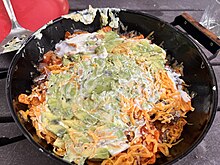

Anaya also opened his own restaurant, Nacho's Restaurant, in Piedras Negras. Anaya's original recipe was printed in the 1954 St. Anne's Cookbook.
The popularity of the dish swiftly spread throughout Texas and the Southwestern United States. The first known appearance of the word "nachos" in English dates to 1949, from the book A Taste of Texas. According to El Cholo Spanish Cafe history, waitress Carmen Rocha is credited with making nachos in San Antonio, Texas, before introducing the dish to Los Angeles at the cafe in 1959.
A modified version of the dish, with cheese sauce and prepared tortilla chips, was marketed in 1976 by Frank Liberto, owner of Ricos Products, during Texas Rangers baseball games at Arlington Stadium in Arlington, Texas. This version became known as "ballpark nachos". During the September 4, 1978 Monday Night Football game between the Baltimore Colts and Dallas Cowboys, sportscaster Howard Cosell enjoyed the name "nachos," and made a point of mentioning the dish in his broadcasts over the following weeks, further popularizing it and introducing it to a whole new audience. Liberto died in 2017.
Ignacio Anaya died in 1975. In his honor, a bronze plaque was erected in Piedras Negras, and October 21 was declared the International Day of the Nacho. Anaya's son, Ignacio Anaya, Jr., served as a judge at the annual nacho competition.
Nutritional information
The nutritional breakdown and total calorie count for a serving of nachos typically depends on the type of nacho, type of cheese, and additional toppings (such as beef, jalapeños, etc.) that are included in the serving. Most typical corn tortilla chips contain about 15 calories per chip. Baked corn tortilla chips have about 6 calories per chip. Mexican-style cheddar cheese contains about 110 calories per ounce. Adding an additional source of protein, such as chicken or beef, increases the calorie count by about 100 calories or so. All in all, a single serving of nachos can contain from 300 to 600 total calories.
A single serving of nachos also contains significant amounts of fat, sodium, and calcium. There are around 16 grams of fat, 816 mg of sodium, and 272 mg of calcium per serving of nachos. In other words, one serving contains 39% of the daily value for fat, 34% of the daily value for sodium, and 27% of the daily value for calcium.
Variations


A variation consists of a quartered and fried tostada topped with a layer of refried beans or various meats and a layer of shredded cheese or nacho cheese, topped with habanero hot sauce.
Other variations include barbecue nachos (in which barbecue sauce is added, sometimes in place of salsa, hot sauce or cheese sauce) and poutine nachos (in which cheddar cheese is replaced with cheese curds and gravy). Although those variations use nontraditional ingredients, these versions are still classified as nachos. In the Southeastern United States, pulled pork nachos, also called barbecue nachos, are very popular. In this variation, the nachos retain their cheese and often jalapeños, but are also topped with pulled smoked pork shoulder served with or without barbecue sauce or hot sauce. Some Irish-themed restaurants and bars serve "Irish Nachos" with toppings placed over potatoes (French fries) instead of tortilla chips. A Pacific Northwestern version of nachos called totchos, or Tot-Chos is a variation in which tortilla chips are replaced with deep-fried or baked tater tots. Although similar, these would not be classified as nachos as they lack tortilla chips, an essential ingredient in nachos.
Traditional nachos consist of the tortilla chips topped with cheese and jalapeños, as done by Anaya. The modern form of nachos has several possible ingredients with the most common toppings being cheese, guacamole, salsa, sour cream, jalapeños, olives, refried beans, ground beef, chicken, and sometimes lettuce. Lettuce is a less common topping, if added at all. Toppings may be served buffet-style to allow diners to create their own nachos. The topping of the greatest quantity is often the cheese.
Nachos vary from the modern style served in restaurants to the quick and easy nachos sold at concession stands in stadiums. The nachos commonly sold at concession stands in the U.S. consists of tortilla chips topped with pump-able cheese sauce. The cheese sauce comes in condensed form to which water or milk and pepper juice are added. What is contained in the condensed form itself is a trade secret. Another variation of nachos is "dessert nachos". These vary widely, from cinnamon and sugar on pita chips to "s'more nachos" with marshmallow and chocolate on graham crackers, and typically refer to a dessert consisting of scattered toppings on some form of crispy base.
Ingredients
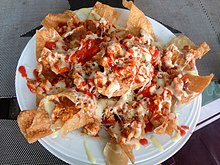
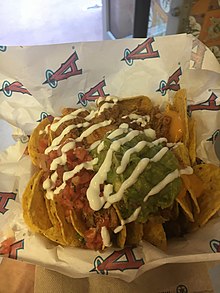
| This section does not cite any sources. Please help improve this section by adding citations to reliable sources. Unsourced material may be challenged and removed. (June 2024) (Learn how and when to remove this message) |
Common toppings include:
- Black beans, pinto beans, or refried beans
- Chile con queso or chili con carne
- Cilantro
- Chives or scallions
- Meat, usually ground beef, sliced steak, chicken, chorizo, or carne asada; occasionally bacon, pepperoni, corned beef, or Spam
- Guacamole
- Jalapeño or other Capsicum peppers, or hot sauce
- Lettuce
- Lime
- Olives
- Onions
- Garlic
- Pickles
- Pico de gallo or salsa
- Sour cream
- Salad dressing
- Ranch dressing
- Tomatoes
See also the common cheeses used:
- Processed cheese
- Cheddar cheese
- Mozzarella cheese
- Cotija cheese
- Oaxaca cheese
- Swiss cheese
- Provel cheese
- Monterey Jack
- Pepperjack cheese
- Cheese curd
Nachos with an abundance of toppings are sometimes called "loaded nachos". This type of dish is usually served as an appetizer at bars or restaurants in the United States and elsewhere. Typically, the tortilla chips are arranged on a platter, meat and refried bean toppings are then added, and the entire platter is smothered with shredded cheese. The platter is then put into a broiler or microwave to cause the cheese to melt. The platter is then covered with the cold toppings (shredded lettuce, tomatoes, salsa, jalapeños, etc.) and served immediately.
In Memphis, Tennessee, barbecue nachos are served in most barbecue restaurants, and also at sporting events. Generous portions of barbecued pork shoulder are placed atop tortilla chips, then covered with melted cheese or nacho cheese, barbecue sauce, and sliced jalapeño peppers.
In Hawaii, kalua pork and pineapple nachos are served in many restaurants and bars. Generous portions of kalua pork and pineapple bits are placed atop tortilla chips, then covered with melted cheese or nacho cheese, and varied toppings.
A similar dish that involves tortilla chips and cheese is found in Tex-Mex restaurants. Small bowls of chile con queso or, more commonly, salsa are served with baskets of warm tortilla chips as appetizers.
Nacho cheese
Main article: Processed cheese See also: Dip (food) § List of common dips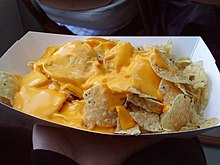
A form of processed cheese sauce mixed with peppers and other spices is often used in place of freshly shredded cheese in institutional or large-scale production settings, such as schools, movie theaters, sports venues, and convenience stores, or wherever using freshly grated cheese may be logistically prohibitive. Though originally formulated as a cheaper and more convenient source of cheese to top nachos, this dip has become popular enough in the U.S. that it is available in some Mexican-themed restaurants, and at major grocery stores, in both name-brand (Frito-Lay, Tostitos, and Taco Bell) and unbranded versions.
In popular culture
In the United States, National Nacho Day is celebrated on November 6. The International Nacho Festival is held between October 13 and 15 at Piedras Negras, the birthplace of nachos, and features live music, art, cultural activities, and a contest for the biggest nacho of the world which is registered with the Guinness World Records.
On April 21, 2012, the world's biggest serving of nachos was made by Centerplate at the University of Kansas in Lawrence, Kansas. It weighed 4,689 lb (2,127 kg) and contained 765 lb (347 kg) of nacho chips, 405 lb (184 kg) of salsa, 323 lb (147 kg) of tomato, 918 lb (416 kg) of meat and beans, and more than 2,200 lb (1,000 kg) of cheese.
A new record was set on September 25, 2022, when a 4,870 lb, or 2,209 kg plate of nachos was served at a promotional event to celebrate a new season for the revived Beavis and Butt-head. Paramount+ held the party at an open air food market in Los Angeles, California. Show creator, Mike Judge, was present for the event and award presentation and said: "This is the proudest moment of my career.” Portions of the food, including leftovers, were packaged and donated to food banks and local homeless shelters.
See also
- List of hors d'oeuvre
- List of maize dishes
- Mexican cuisine
- Cuisine of California
- Nacho cheese
- Nacho Cheese Doritos
- Tex-Mex cuisine
- Texan cuisine
Notes
- 1. In the original published accounts quoting Anaya, Sr., he says that he added the jalapeño before heating them. However, Anaya's son, Ignacio Anaya, Jr., is quoted as saying "My father was maître d' and he said 'Let me go quick and fix something for you.' He went into the kitchen, picked up tostadas, grated some cheese on them—Wisconsin cheese, the round one—and put them under the salamander (a broiling unit that browns the top of foods). He pulled them out after a couple of minutes, all melted, and put on a slice of jalapeño."
References
- Tijerina, Edmund. "How Nachos Became an International Hit". Texas Highways.
- Bays, Harold Edward; Muñoz-Mantilla, Doris X.; Morgan, Ryan; Nwizu, Chima; Garcia, Theresa “Tess” (1 March 2022). "Obesity Pillars Roundtable: Obesity and Diversity". Obesity Pillars. 1: 100008. doi:10.1016/j.obpill.2021.100008. ISSN 2667-3681. PMC 10662096. PMID 37990704.
Traditional Mexican foods include pork goat, seafood, and chicken, white cheeses, often corn tortillas, crema, lime juice, and raw onions. Examples of Tex-Mex foods include nachos, chili con carne or queso, and fajitas.
- Wheaton, Dennis Ray; Carroll, Glenn R. (1 January 2017). "Where did "Tex-Mex" come from? The divisive emergence of a social category". Research in Organizational Behavior. 37: 143–166. doi:10.1016/j.riob.2017.09.003. ISSN 0191-3085.
Tex-Mex typically implies concretely items such as chili con carne, nachos, fajitas and combination plates, among other food items; it usually also implies yellow cheese, cumin, corn chips, and chili powder among other ingredients.
- Colllins, Kimberly; Kohout, Michal (2020). "Regional Geographies of the US-Mexico Border". In Jackiewicz, Edward L.; Bosco, Fernando J. (eds.). Placing Latin America: Contemporary Themes in Geography (Fourth ed.). Lanham: Rowman & Littlefield. ISBN 9781538126295.
The lower Rio Grande region is considered the heartland of Tex-Mex culture, partly defined by its distinct food such as fajitas, nachos, and enchiladas...
- "Who Invented Nachos?". HuffPost. 15 May 2012.
While nachos are often served at Mexican-American restaurants, they're not a typical Mexican dish. And even though nachos were invented in Mexico, they were created for an American palate.
- Saavedra, Tania Alemán (2019-08-15). "Ignacio Anaya, el mexicano que inventó los nachos". México Desconocido (in Spanish). Retrieved 2020-11-04.
- "Lo que conocemos como nachos, en realidad se llaman totopos | CM Abastos". www.cmabastos.es. Retrieved 2020-11-04.
- Spanish Word Histories and Mysteries: English Words That Come From Spanish. Houghton Mifflin Harcourt. 2007. p. 157. ISBN 9780547350219. Archived from the original on 17 May 2015. Retrieved 7 March 2015.
- Strong, Franklin (2012). Herrera-Sobek, Maria (ed.). Celebrating Latino Folklore: An Encyclopedia of Cultural Traditions. ABC-CLIO. p. 825. ISBN 9780313343407. Retrieved 26 March 2016.
- ^ LaRoche, Clarence J. (1954). "Nachos? Natch!". San Antonio Express and San Antonio News.
- "Action Line". Corpus Christi Caller-Times. 25 March 1974.
- ^ Orr, Adriana P. (July 1999). "Nachos, anyone?". OED News. Oxford University Press. Archived from the original on 2010-01-02. Retrieved 2011-07-26.
- ^ Haram, Karen (2002-02-14). "The Legend of Nacho's Appetizer". Sun Sentinel. Sun Sentinel. Retrieved 22 August 2022.
- Jinich, Pati (2020-11-02). "The Original Nachos Were Crunchy, Cheesy and Truly Mexican". The New York Times. ISSN 0362-4331. Retrieved 2020-11-03.
- "Waitress Who Introduced L.A. To Nachos Dies". Morning Edition. October 17, 2008. National Public Radio. Archived from the original on April 11, 2018. Retrieved April 5, 2018.
- K. Annabelle Smith (May 7, 2013). "The History of Baseball Stadium Nachos". Smithsonian. Archived from the original on May 10, 2013. Retrieved May 13, 2013.
- Munsey; Suppes. "Arlington Stadium". Ballparks.com. Archived from the original on 2010-01-02. Retrieved 2008-12-30.
- "History". Originators of Concession Nachos. Ricos Products Co., Inc. Archived from the original on 2009-02-14. Retrieved 2008-12-30.
- Sokolov, Raymond (2006-02-06). "The Search for the Perfect Nacho". Wall Street Journal. Archived from the original on 2019-08-16. Retrieved 2008-06-27.
- David Hendricks (November 7, 2017). "'Father of nachos' Liberto dies day shy of National Nacho Day". mysanantonio.com. Archived from the original on December 16, 2017. Retrieved December 16, 2017.
- Ellerbee, Linda (2005). Take Big Bites: Adventures Around the World and Across the Table. Penguin. pp. 73–74. ISBN 0-399-15268-7. Archived from the original on 2018-04-11. Retrieved 2016-11-05.
- Wasserman, Robin. "Calories in Nachos & Cheese". LIVESTRONG.COM. Archived from the original on 2017-04-10. Retrieved 2017-04-10.
- "Nachos, with cheese Fast foods nutrition". www.weightchart.com. Archived from the original on 2017-04-10. Retrieved 2017-04-10.
- "The Ultimate Nacho Infographic". www.nachosny.com. Archived from the original on 2017-02-24. Retrieved 2017-04-10.
- "The History of Baseball Stadium Nachos". www.smithsonianmag.com. Archived from the original on 2017-04-11. Retrieved 2017-04-10.
- "Dessert Nachos". www.julieseatsandtreats.com. Archived from the original on 2017-04-11. Retrieved 2017-04-10.
- "21 Dessert Nachos". www.buzzfeed.com. Archived from the original on 2017-05-11. Retrieved 2017-04-10.
- "Our Food: The Menu: Nachos & Sides". Tacobell.com. Taco Bell Corporation. Archived from the original on 2017-04-11. Retrieved 2008-12-30.
- "NationalNachosDay.com". NationalNachosDay.com. Archived from the original on 2016-05-29. Retrieved 2017-04-09.
- ^ Land, Carla. "International Nacho Festival at Piedras Negras, Mexico". mexicolesstraveled.com. Archived from the original on 2016-10-16. Retrieved 2017-04-09.
- ^ "Largest serving of nachos". Guinness World Records. Archived from the original on 2017-04-10. Retrieved 2017-04-09.
- ^ "Largest serving of nachos". Guinnessworldrecords.com. Retrieved August 5, 2024.
- Graves, Wren (September 30, 2022). "Mike Judge's Beavis and Butt-Head Party Breaks Guinness Record for Largest Nachos". Consequence.net. Retrieved August 5, 2024.
- "Mike Judge's Beavis and Butt-Head Nacho Stunt". Shortyawards.com. Retrieved August 5, 2024.
Further reading
- Dunne, Mike. (January 28, 2004). "One spicy tale: 'Macho Nachos'". Sacramento Bee, p. F1.
- Nickel, Sandra and Oliver Dominguez. (2020). Nacho's Nachos: The Story Behind the World's Favorite Snack. ISBN 9781620143698
External links
 Media related to Nachos at Wikimedia Commons
Media related to Nachos at Wikimedia Commons Nachos at the Wikibooks Cookbook subproject
Nachos at the Wikibooks Cookbook subproject The dictionary definition of nachos at Wiktionary
The dictionary definition of nachos at Wiktionary
| Mexican cuisine | |||||||||||
|---|---|---|---|---|---|---|---|---|---|---|---|
| List of Mexican dishes | |||||||||||
| Soups and stews | 
 | ||||||||||
| Rice and pasta dishes | |||||||||||
| Bean dishes | |||||||||||
| Egg dishes | |||||||||||
| Vegetable dishes | |||||||||||
| Meat dishes |
| ||||||||||
| Other protein dishes | |||||||||||
| Cheese dishes | |||||||||||
| Antojitos |
| ||||||||||
| Sauces and condiments | |||||||||||
| Desserts and sweets | |||||||||||
| Salads | |||||||||||
| Breads | |||||||||||
| Beverages | |||||||||||
| Variants |
| ||||||||||
| Maize and corn | |||||||||||||||
|---|---|---|---|---|---|---|---|---|---|---|---|---|---|---|---|
| Varieties | |||||||||||||||
| Parts | |||||||||||||||
| Processing | |||||||||||||||
| Pathology | |||||||||||||||
| Production | |||||||||||||||
| Culture |
| ||||||||||||||
| Maize dishes |
| ||||||||||||||









